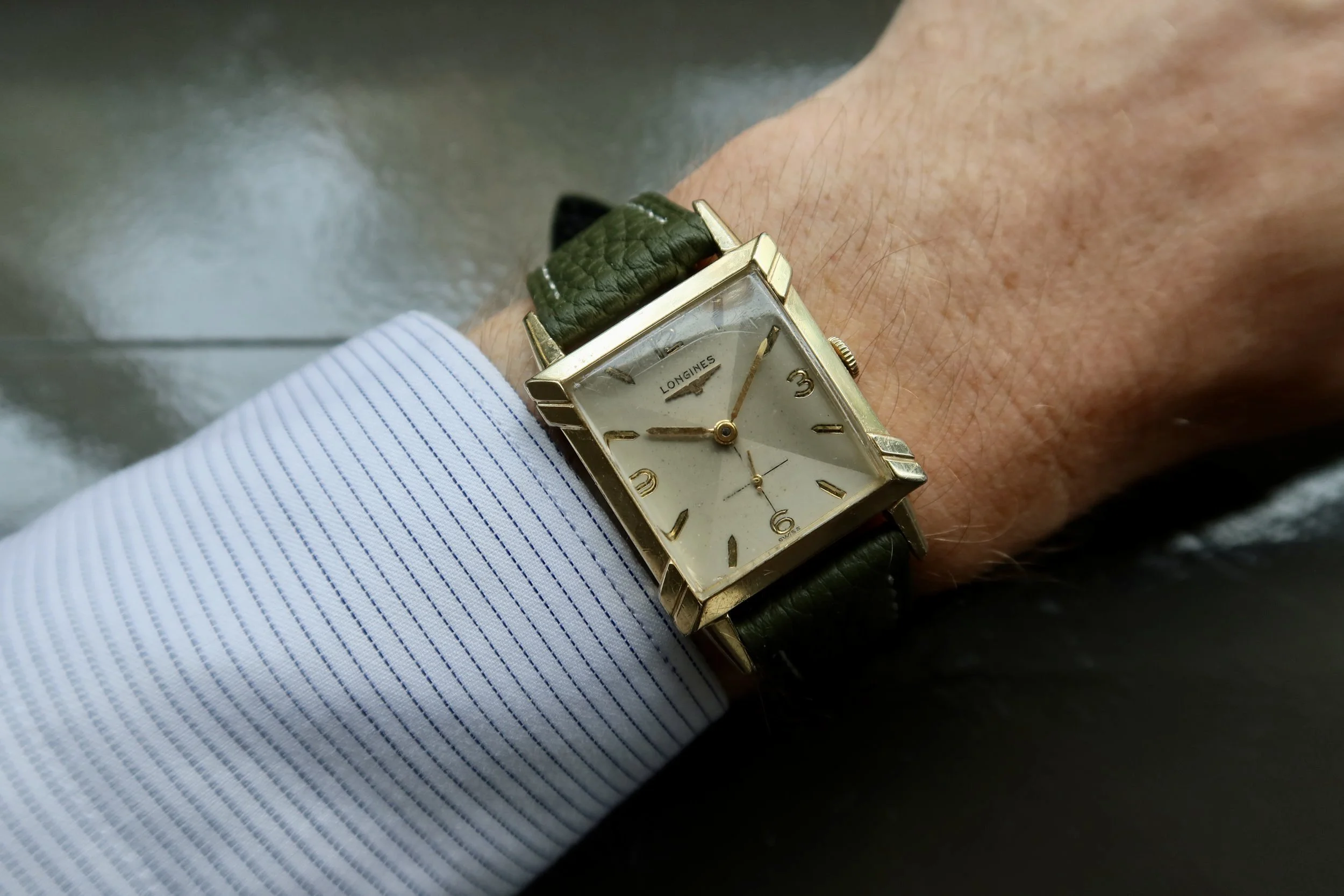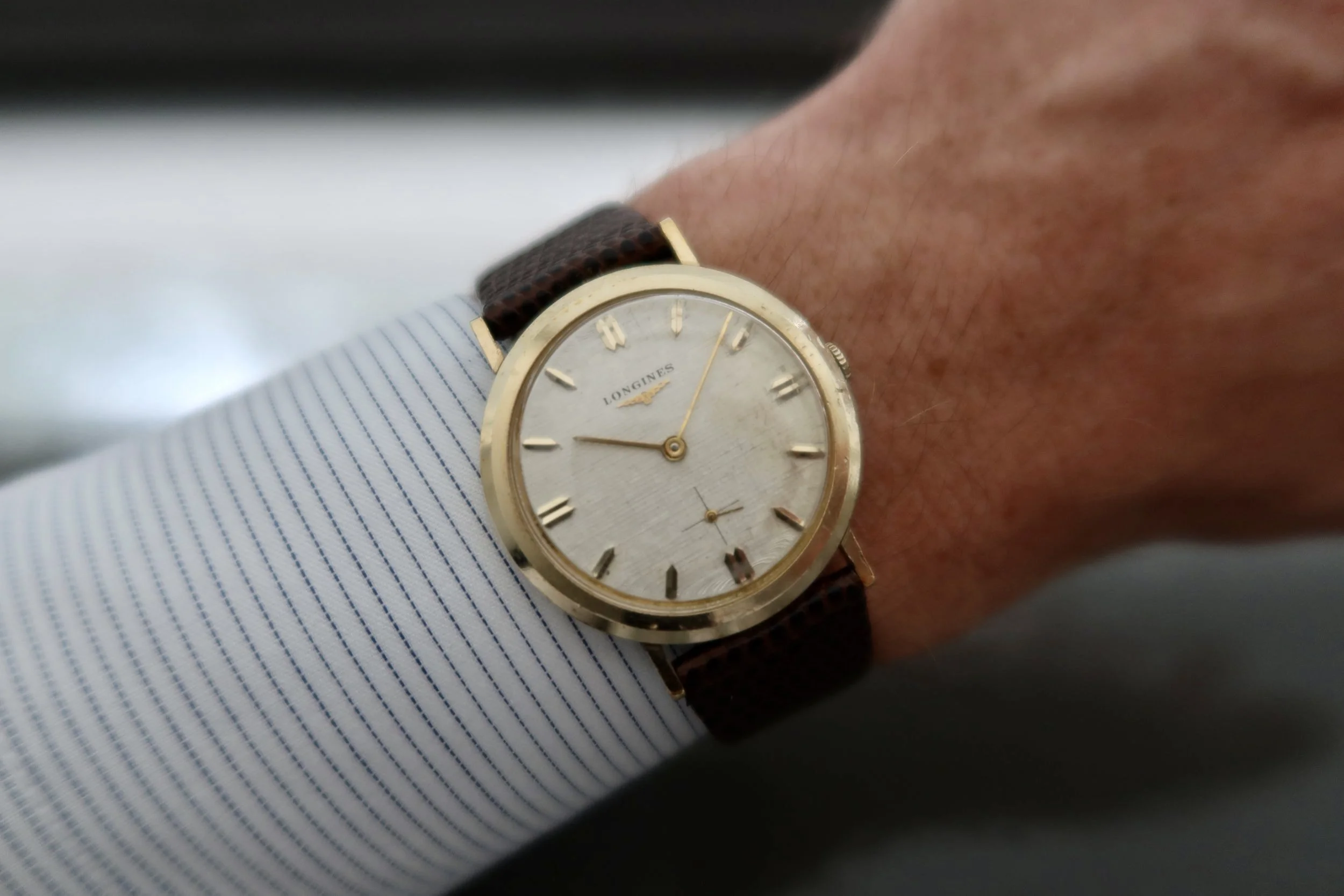The 1954 Solid Gold Longines reference 727-S-724-40
This year, trends in watches have been clear. Smaller sizes are becoming more popular, and additional flair a watch can bring is desired. Whether that flair comes from stone dials, interesting case design, or diamonds, collectors seem to know what they are looking for. What is extremely important though, is that the flair the watch brings was how it was produced by the original manufacture. It means the references one would wear is off the traditional path for the company, and gives the watch a bit more exclusivity for the collector.
There are plenty of watches that come to mind that fit this trend. I highly recommend you check out Monaco Legend Group’s Instagram because they have showcased some extremely special pieces this year with incredible factory set diamonds to many sports model Rolex watches. The question comes up though - what does this mean for vintage watches? Naturally, odd-ball references have become more important to collectors. But something else that has gained popularity is diamond-set dial vintage watches, and today we will look at a very special vintage Longines with that motif.
The watch is the reference 727-S-724-40. This watch, like many others covered on Life on the Wrist, seems to be a rare reference. The watch was manufactured in 1954 and searching online, there was one other example that was for sale in London. The reference is a 34mm watch, cased in 14k solid yellow gold. Typically, when collectors look for vintage Longines there is always an abundance of gold filled or gold plated watches. Solid gold watches are quiet uncommon, which makes this watch a bit more special. On the case back of the watch, one can find the inscription “D&A” written twice (on the inside of the case back, and at the top of the outside of the case back). This inscription is reference the casemaker. The case was manufactured by DiVincenzo & Arienti, a Brooklyn-based case maker who manufactured cases for brands like Longines, Omega, Rolex, and Hamilton. Swiss brands were taxed at quite high rates during this period for importing cases. To avoid the high taxes, many brands would commission cases to be made in the USA that were destined to be sold in the USA. This reference is a good example of this.
The case has a very strong impression. The two-piece case gets its strong looks from the way the lugs integrate with the watch. The lugs do not have much curve to them, so they point quite straight out of the watch. There are some attractive bevels on the right and left side of each of the lugs and the way the lug inserts to the case is extremely strong. Sure at 34mm one may think the watch would sit smaller, but the lug design forces the watch a few sizes up.
As mentioned previously, the watch was destined for the USA market. It was sold by the Longines-Wittnauer Watch Company that operated out of New York and Montreal. The companies name is engraved on the inside case back. Wittnauer was a successful brand in the USA, and was acquired by Longines in 1950, just after World War II where they became a distribution partner for Longines. In 1969, Longines-Wittnauer was sold to Westinghouse Electric Corporation and in 1994, Longines ended their distribution relationship with Wittnauer. But, during their partnership, many different models hit the market that are of interest to collectors today.
But, not all pieces of the watch were manufactured in the USA. The watch is running on the caliber 23ZS movement. On the bridge that suspends the balance wheel, one can see an engraving that reads “LXW”. This inscription was the import code used by the Longines Wittnauer group when they imported movements from Switzerland to the USA. So, it is likely this movement was put together in Switzerland, shipped and imported to the USA. It then met up with it’s 14k solid yellow gold case made by DiVincenzo & Arienti.
The caliber 23ZS movement is a fairly historic movement for Longines. It was introduced in 1948 and was an upgrade from its predecessor, the caliber 10.68Z that was introduced in 1925. To upgrade the movement, the movement had a shock resistance system and anti-magnetic protection which were both concepts that were made extremely evident after World War II. It is also quite historic considering how much of an impact the War had on European economies, so to release a new caliber so close afterwards was astonishing. The watch features a center seconds complication, whereas the sister movement, the caliber 23Z had a subsidiary seconds. The steel movement has an incredibly beautiful look to it. Beautifully constructed and really attractive to look at.
One of features not yet discussed is the dial. The dial has quite a few special parts to it. The watch has a two sector-like dial. The inner sector of the dial has a painted minute track that is where the main elements of the time is told. Looking at the Longines signature above the gold applied Longines logo, it is likely the dial has been polished and refinished. The “G” in the Longines name on the dial is missing features that is normally seen on there signature. But it does not detract too much from the overall beautiful look of the watch. Moving to the outer sector, the sector is raised and has beautiful guilloche finishing that is applied to every other hour marker which are gold, and match the dauphine hands. This alone is worth pulling out a loupe and being mesmerized for a few minutes. Then, at the 12, 3, 6, and 9 hour markers, the wedge-style hour markers are replaced with round-cut diamonds. This extra feature gives the watch a whole differently level of interest. These subtle features (guilloche finishing, round cut diamonds, solid gold case) give the watch understated features that can be enjoyed by the wearer.
The watch has an original Longines watch box, service booklet, and guarantee and instructions manual from the 1950’s. It is likely they are not what original came with this watch though. The guarantee and instructions manual features a purchase date written in from 1950, which was four years before the watch was manufactured. Nevertheless, it is nice to have a box and documents that came with Longines watches during this era. It keeps the watch true to what it probably would have been like to buy a piece like this in 1950.
There are plenty of old sayings that discourage the following of trends and to focus on classics. While diamond dials seem to be a huge trend this year, this watch is everything but a trend. The subtle details that collectors know about this watch give it way more meaning, and place it nicely amongst watches that could be classified as classics. It is another great example of how Longines stood among giants during this era.
Enjoy!









